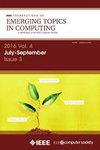SelfVis: Self-Supervised Learning for Human Activity Recognition Based on Area Charts
IF 5.1
2区 计算机科学
Q1 COMPUTER SCIENCE, INFORMATION SYSTEMS
IEEE Transactions on Emerging Topics in Computing
Pub Date : 2024-03-03
DOI:10.1109/TETC.2024.3392850
引用次数: 0
Abstract
Human activity recognition (HAR) has long been an active research topic as it enables us to infer human behaviors and daily routines from sensor data collected on wearables or on sensors embedded in a pervasive sensing environment. In recent years, deep learning has been widely used in HAR for feature extraction and multimodal fusion, and has achieved promising performance on activity recognition. However, they often require a large number of labeled data for training. To directly tackle this challenge, this paper proposes SelfVis, a novel visualization-based self-supervised learning technique, which aims to extract effective features without the need of labeled data. To achieve this goal, it encodes time-series IMU sensor readings into images and then employs ResNet, a pre-trained, state-of-the-art convolutional neural network (CNN) as the backbone feature extractor. It leverages the fact that there exist multiple sensors often being used and uses sensor identifications that are generated automatically as a prediction target during the self-supervised learning process. With these two, SelfVis has achieved high activity recognition accuracy even when only a small number of labeled data are available; that is, with only 1% training data, SelfVis has demonstrated the ability to achieve higher performance than state-of-the-art techniques by up to 0.46 in macro F1-scores.SelfVis:基于区域图的人类活动识别自我监督学习
人类活动识别(HAR)长期以来一直是一个活跃的研究课题,因为它使我们能够从可穿戴设备或嵌入在无处不在的传感环境中的传感器收集的传感器数据中推断人类的行为和日常生活。近年来,深度学习被广泛应用于HAR的特征提取和多模态融合,并在活动识别方面取得了良好的效果。然而,它们通常需要大量的标记数据进行训练。为了直接解决这一挑战,本文提出了一种新的基于可视化的自监督学习技术SelfVis,该技术旨在在不需要标记数据的情况下提取有效特征。为了实现这一目标,它将时间序列IMU传感器读数编码到图像中,然后使用ResNet(一种预训练的、最先进的卷积神经网络(CNN))作为主干特征提取器。它利用了经常使用多个传感器的事实,并使用自监督学习过程中自动生成的传感器识别作为预测目标。通过这两种方法,即使只有少量标记数据可用,SelfVis也能达到很高的活动识别精度;也就是说,只有1%的训练数据,SelfVis已经证明了比最先进的技术实现更高性能的能力,其宏观f1分数高达0.46。
本文章由计算机程序翻译,如有差异,请以英文原文为准。
求助全文
约1分钟内获得全文
求助全文
来源期刊

IEEE Transactions on Emerging Topics in Computing
Computer Science-Computer Science (miscellaneous)
CiteScore
12.10
自引率
5.10%
发文量
113
期刊介绍:
IEEE Transactions on Emerging Topics in Computing publishes papers on emerging aspects of computer science, computing technology, and computing applications not currently covered by other IEEE Computer Society Transactions. Some examples of emerging topics in computing include: IT for Green, Synthetic and organic computing structures and systems, Advanced analytics, Social/occupational computing, Location-based/client computer systems, Morphic computer design, Electronic game systems, & Health-care IT.
 求助内容:
求助内容: 应助结果提醒方式:
应助结果提醒方式:


